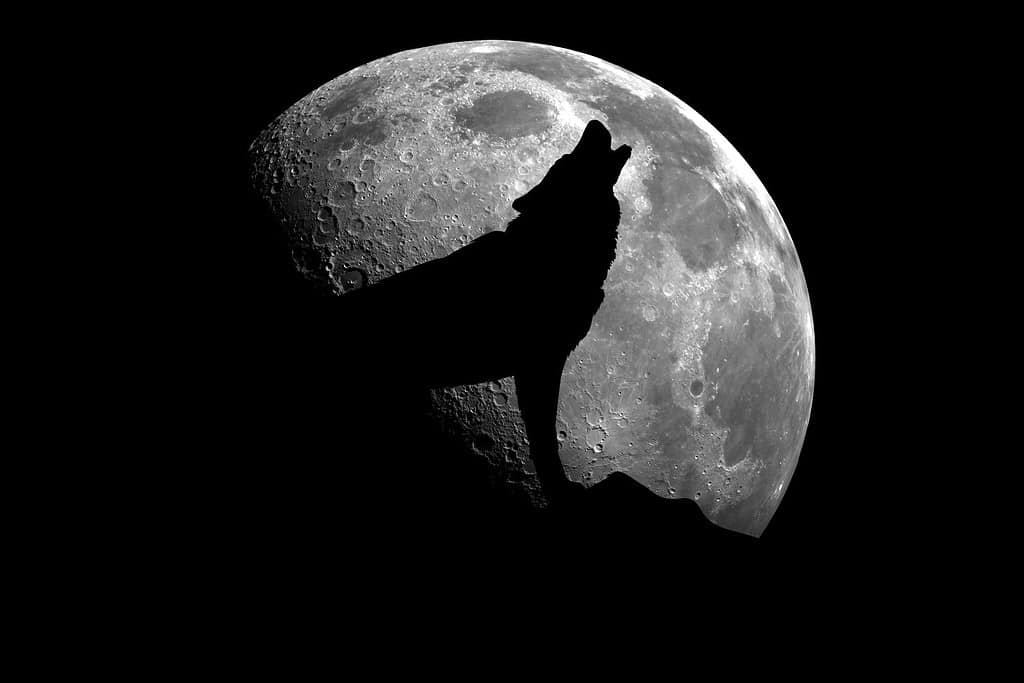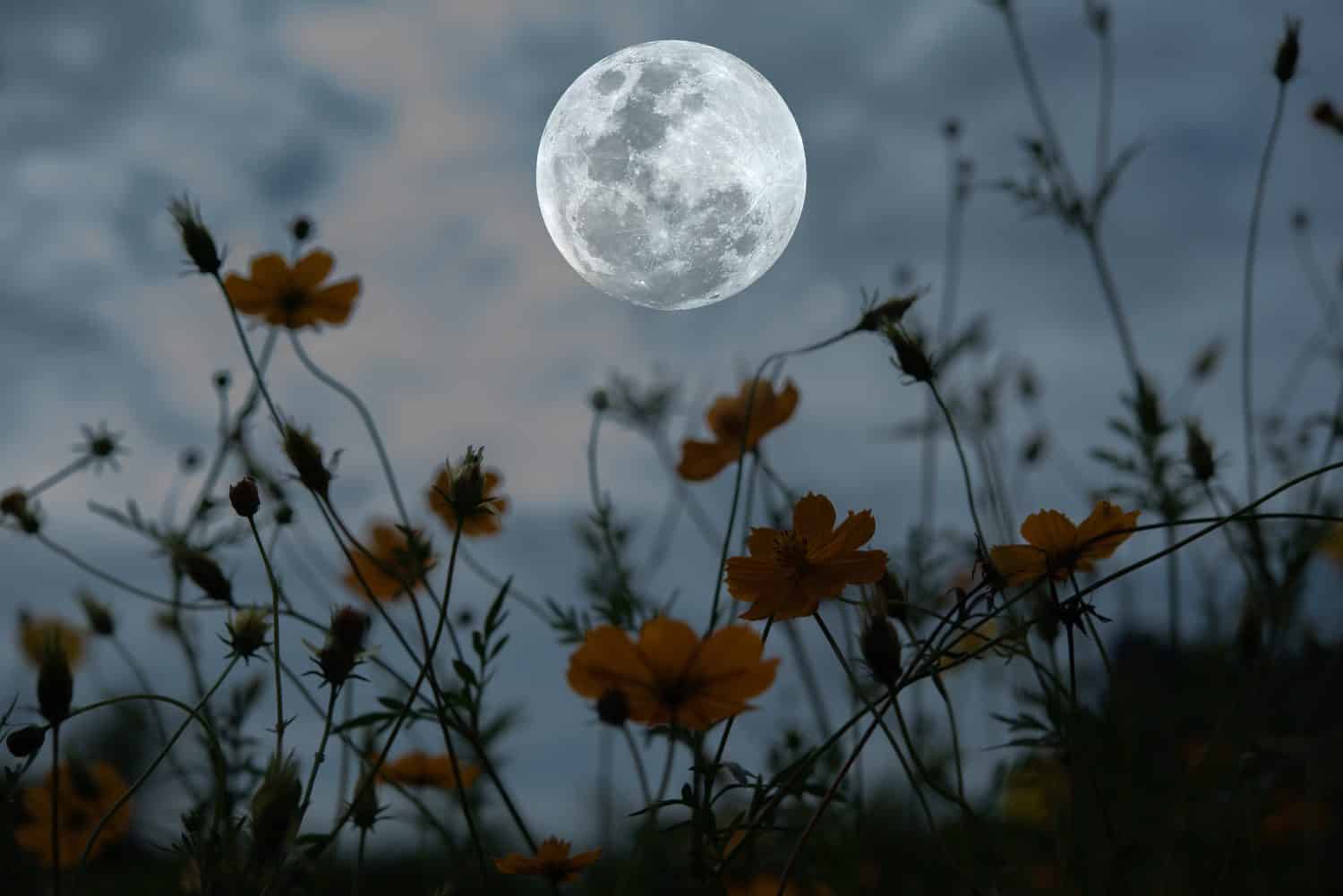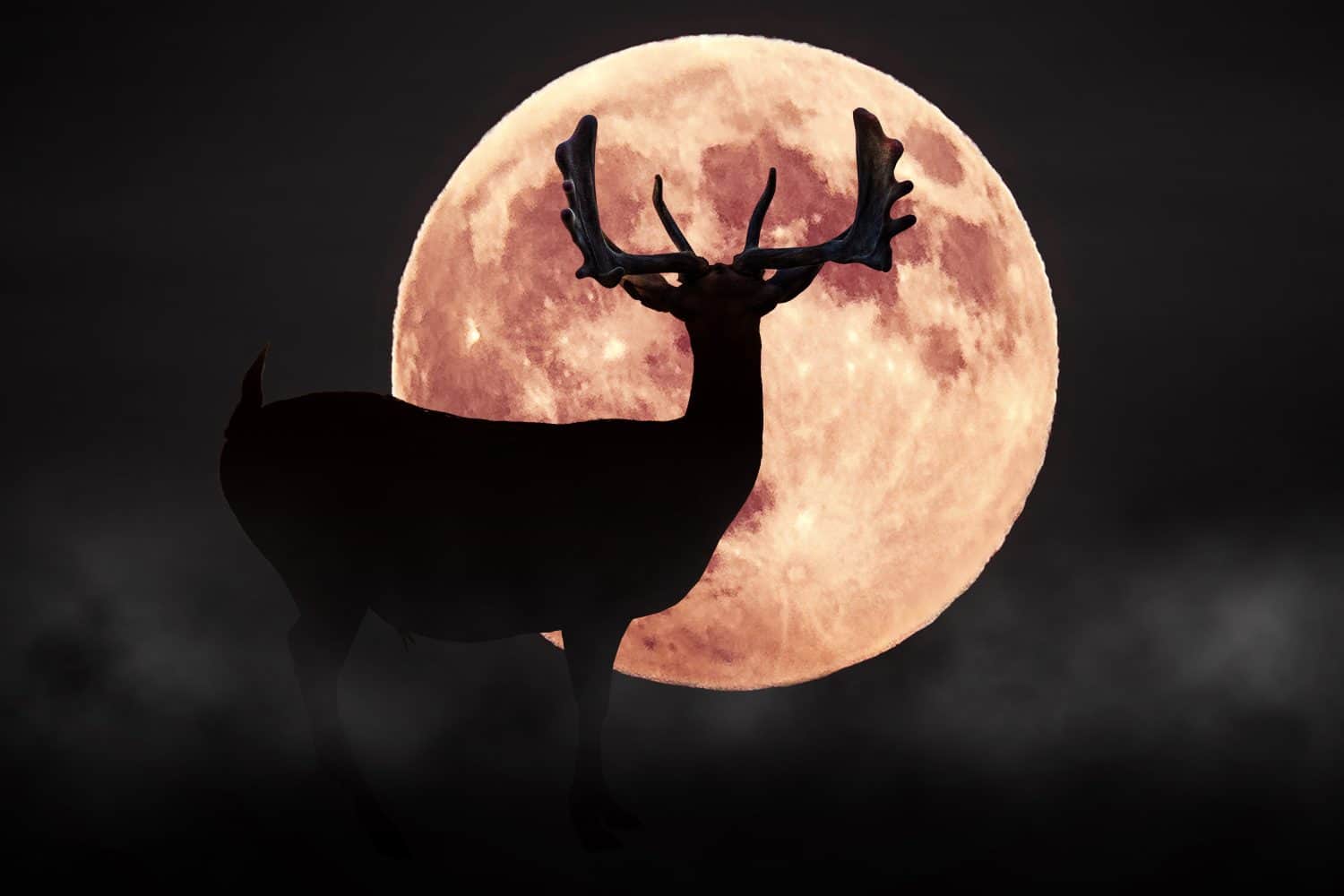A big, bright, full moon is a wonder to behold. Worldwide, people celebrate and admire this monthly celestial event. The Xhosa of South Africa carefully schedules important events during full moons. In Sri Lanka, they celebrate every full moon as a Buddhist holiday. The Maori and many other peoples traditionally use a lunar calendar to track the passage of time. Are you curious about upcoming full moons? Read on to discover the names and exact dates of each full moon in 2024 and learn some interesting facts about how people celebrate full moons around the world. The names we list here for full moons come from the Farmer’s Almanac; indigenous American names and traditional European names inspire them.
Writer’s note: Please note that the below 2024 full moon calendar dates may differ in Australia and other time zones.
January 25th—Wolf Moon

Wolves do not actually howl at the moon, but they are nocturnal, so you’re most likely to hear them howl at night.
©Denis Andricic/Shutterstock.com
The first full moon of 2024 is often called the Wolf Moon. The Ancient Celts associated it with the howling of wolves in the dead of winter. The Celts also refer to this full moon as the Rowan Moon, after a tree said to protect people against black magic. Native American and First Nations traditional names for the Wolf Moon include Frost Exploding Moon (Cree), Spirit Moon (Ojibwe), and Canada Goose Moon (Tlingit). The Sioux call it the Moon, Where Wolves Run Together. The Zulu call this moon uMasingana, which describes it as suspiciously peeping out at the world.
You can howl at the Wolf Moon on January 25th in 2024. Followers of astrology will note that this full moon is in Leo.
February 24th—Snow Moon

The Cherokee called February’s full moon the
Hungry Moonbecause it marked a time when warm weather supplies dwindled, and food was still hard to come by.
©Alones/Shutterstock.com
Many refer to February’s full moon as the Snow Moon because of the snowy weather dominating February in the northern hemisphere’s colder parts. This full moon has many other names in Native American cultures, including Hungry Moon (Cherokee), Raccoon Moon (Dakota), and Black Bear Moon (Tlingit). The Zulu call this moon uNhlolanja, which means the dog-ruling moon. According to the Celtic Tree Calendar, this full moon is the Ash Moon, in reference to the sacred World Tree.
Build a snowman under the Snow Moon on February 24th in 2024. In astrology, this full moon is in Virgo.
March 25th—Worm Moon
With the arrival of the Spring Equinox on March 19th comes a thawing of winter frost. Warmer weather means worms galore! That’s why March’s full moon is commonly called the Worm Moon. Native American names for this full moon include Snow Crust Moon (Anishinaabe), Sore Eyes Moon (Assiniboine, Dakota, and Lakota), and Wind Strong Moon (Pueblo). The Ojibwe call it the Sugar Moon in honor of the maple sap that begins to flow at this time of year. Europeans sometimes call it the Lenten Moon because it coincides with the Christian observance of Lent.
The Worm Moon squirms its way into the sky on March 25th in 2024. On this night, look out for a penumbral eclipse, in which the Earth’s shadow passes over the face of the Worm Moon. In astrology, this full moon is in Libra.
April 23rd—Pink Moon
Creeping Phlox (Phlox subulata) is one of the first flowers to bloom in spring in the Eastern and Central United States. By April, this pretty flower has covered much of the ground in a carpet of pink blooms. Hence, the common name for April’s full moon: the Pink Moon. Other Native American names for it include Broken Snowshoe Moon (Anishinaabe) and Moon When the Ducks Come Back (Lakota). In the Celtic tradition, this is the Willow Moon, as the willow tree represents dreams and intuition, plus has an association with spring.
Blush in the light of the Pink Moon on April 23rd in 2024. In astrology, this full moon is in Scorpio.
May 23rd—Flower Moon

The Algonquin referred to May’s full moon as the
Flower Moon, the
Corn-Planting Moon, and the
Milk Moon.
©Onkamon/Shutterstock.com
April showers bring May flowers, and it’s no surprise that the full moon in May is commonly called the Flower Moon. The Zulu named this moon uNhlaba after blooming aloe flowers. The First Nations Cree have many different names for it: Budding Moon, Egg-Laying Moon, and Frog Moon. Vesak Day, the most important holiday in Buddhism, takes place on the day of the full moon every May. This sacred day is said to mark the Buddha’s birth, his enlightenment, and his death.
Catch the Flower Moon blossoming on May 23rd in 2024. In astrology, this full moon is in Sagittarius.
June 22nd—Strawberry Moon
Strawberry season in North America is an exciting time for anyone who enjoys the tasty berry. That’s why June’s full moon is called the Strawberry Moon. Native American names for this full moon include Green Corn Moon (Cherokee) and Birth Moon (Tlingit). The Celtic name for this moon means Oak Moon. Other European names for it include Rose Moon and Hot Moon.
The Strawberry Moon will be ripe for viewing on June 22nd in 2024. In astrology, this is the first of two consecutive full moons in Capricorn.
July 21st—Buck Moon

Bucks have large antlers in July when the Buck Moon rises.
©Ruslan Harutyunov/Shutterstock.com
Bucks (male deer) shed and regrow their antlers every year. At the time of July’s full moon, bucks are at the peak of their antler growth, hence the name of this full moon. The Buck Moon is also called Thunder Moon (Western Abenaki), Raspberry Moon (Ojibwe), and Salmon Moon (Tlingit). It is called the Hungry Ghost Moon in China. In Celtic mythology, the Holly King and the Oak King are battling brothers, and so July’s full moon (which follows June’s Oak Moon) is the Holly Moon.
Fawn over the Buck Moon on July 21st in 2024. In astrology, this is the second of two consecutive full moons in Capricorn.
August 19th—Sturgeon Moon
In August, lake sturgeon (Acipenser fulvescens) can be found in huge numbers in Lake Michigan and nearby freshwater bodies. That’s why the Algonquin and other indigenous American groups began referring to August’s full moon as the Sturgeon Moon. The Assiniboine call it the Black Cherries Moon, and the Tlingit call it the Mountain Shadows Moon. South Africans celebrate National Women’s Day and International Day of the World’s Indigenous People on August 9th, and they honor these holidays by calling August’s full moon the Peace Moon.
Go for a moonlight swim under the Sturgeon Moon on August 19th in 2024. In astrology, this full moon is in Aquarius.
September 18th—Harvest Moon or Corn Moon

Every three years, the Harvest Moon falls in October. In 2024, it is in September.
©Matusciac Alexandru/Shutterstock.com
When September’s full moon is the closest one to the autumnal equinox, people call it the Harvest Moon. 2024 is such a year. (In some other years, the Harvest Moon falls in October.) Its name references the plentiful harvests that people associate with Autumn, particularly the corn harvest. September’s full moon is also traditionally called the Corn Moon. The Anishinaabe call it the Leaves Turning Moon, and the Tlingit call it the Child Moon. In China and other East Asian countries, people celebrate the Mid-Autumn Festival by eating special mooncakes under the light of September’s full moon.
Get your popcorn and view the Harvest Moon/ Corn Moon, which will appear as a supermoon on September 18th in 2024. Keep your eye out for a partial lunar eclipse! In astrology, this full moon is in Pisces.
October 17th—Hunter’s Moon
October’s bright full moon, the reduction of leaves in the trees, and the plumpness of well-fed game animals that have enjoyed the abundance of summer and autumn all make the October full moon a perfect time for hunting. The Hunter’s Moon is also called the Falling Leaves Moon (Anishinaabe) and the Migrating Moon (Cree). The Celts refer to this full moon as the Ivy Moon. This is in reference to the moon goddess Arianrhod, to whom ivy was said to be sacred.
It won’t be hard to hunt out the Hunter’s Moon, which will appear as a supermoon on October 17th in 2024. In astrology, this full moon is in Aries.
November 15th—Beaver Moon
November’s full moon is called the Beaver Moon because it marks the time when beavers build their winter shelters. This is a time when trappers would hunt beavers for their pelts. The Dakota and Lakota also call this full moon the Deer Rutting Moon. The Zulu call it uLwezi after the cicada grubs that begin to appear at this time.
Tell your friends that you’ll be busy as a beaver on November 15th, 2024, when it’s time to view the Beaver Moon. In astrology, this full moon is in Taurus.
December 15th—Cold Moon

Long winter nights make the Cold Moon easier to see than other full moons.
©YouraPechkin/Shutterstock.com
Anyone who lives in a cold climate in the Northern Hemisphere understands why December’s full moon is called the Cold Moon. In December, the air is frigid, and the nights are long. The Mohicans call this moon the Long Night Moon. In Europe, it has traditionally been called the Moon Before Yule.
Bundle up and look for the Cold Moon on December 15th in 2024. In astrology, this full moon is in Gemini.
| Date in 2024 | Full Moon Name |
|---|---|
| January 25 | Wolf Moon |
| February 24 | Snow Moon |
| March 25 | Worm Moon |
| April 23 | Pink Moon |
| May 23 | Flower Moon |
| June 22 | Strawberry Moon |
| July 21 | Buck Moon |
| August 19 | Sturgeon Moon |
| September 18 | Harvest Moon (Corn Moon) |
| October 17 | Hunter’s Moon |
| November 15 | Beaver Moon |
| December 15 | Cold Moon |
The photo featured at the top of this post is © jakkapan/Shutterstock.com
Thank you for reading! Have some feedback for us? Contact the AZ Animals editorial team.






